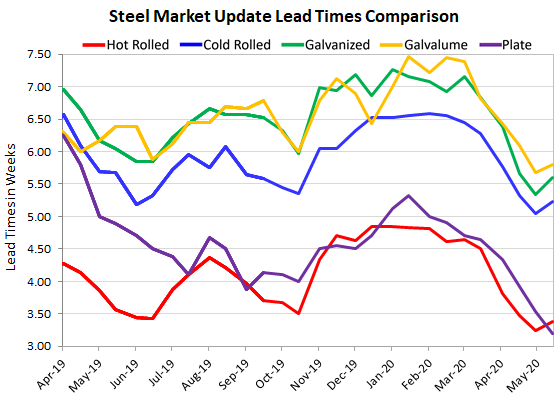SMU Data and Models

Steel Mill Lead Times: Extend Slightly
Written by Tim Triplett
May 14, 2020
Lead times for spot orders of flat rolled steel extended slightly this week after declining since mid-March when the government ordered the closing of nonessential businesses to stop the spread of the coronavirus. Lead times for steel delivery are a measure of demand at the mill level—the longer the lead time, the busier the mill. Lead times are also a measure of the strength of the recent price increase announcements. Note, the lead times shown come from the SMU flat rolled and plate steel market trends survey just concluded earlier today. The lead times referenced are not from any one specific mill, and domestic mill lead times can vary from producer to producer and for each production facility.
Hot rolled lead times now average 3.38 weeks, up from 3.25 at the end of April. Cold rolled orders currently have a lead time of 5.23 weeks, up from 5.04 two weeks ago. The current lead time for galvanized steel is 5.60 weeks, up from 5.34, while Galvalume is at 5.80 weeks, up from 5.67 in SMU’s late April check of the market.
Plate is the exception with plate lead times shortening to 3.20 weeks from 3.53 weeks over the same period.
Steel producers have idled furnaces and curtailed production in a massive effort to sync supply with the reduced demand from the coronavirus shutdowns. Lead times for steel delivery could be expected to extend further as businesses reopen in the coming weeks and months and steel demand improves.

Note: These lead times are based on the average from manufacturers and steel service centers who participated in this week’s SMU market trends analysis. Our lead times do not predict what any individual may get from any specific mill supplier. Look to your mill rep for actual lead times. Our lead times are meant only to identify trends and changes in the marketplace. To see an interactive history of our Steel Mill Lead Times data, visit our website here.

Tim Triplett
Read more from Tim TriplettLatest in SMU Data and Models

SMU’s June at a glance
A look at SMU data for the month of June.

SMU Survey: Buyers’ Sentiment rebounds from multi-year low
Both of SMU’s Steel Buyers’ Sentiment Indices edged higher this week. Current Sentiment rebounded from a near five-year low, while Future Sentiment rose to a two-month high

SMU flat-rolled market survey results now available
SMU’s latest steel buyers market survey results are now available on our website to all premium members.

SMU Survey: Sheet lead times pull back after early-June blip, plate holds
Following the uptick seen two weeks ago, lead times eased this week for all four sheet products tracked by SMU, while plate lead times held steady, according to this week’s market survey.

SMU Survey: Pricing power abruptly shifts to steel buyers
The majority of steel buyers responding to our latest market survey say domestic mills are more willing to talk price on sheet and plate products than they were earlier this month. Sheet negotiation rates rebounded across the board compared to early June, while our plate negotiation rate hit a full 100%.
